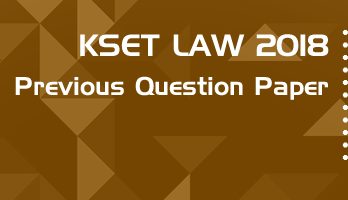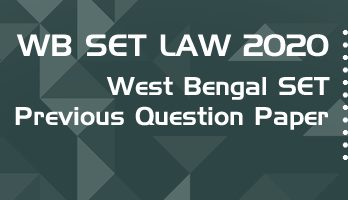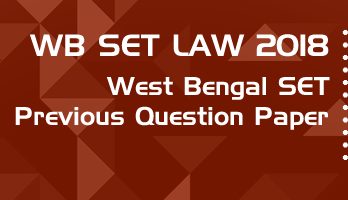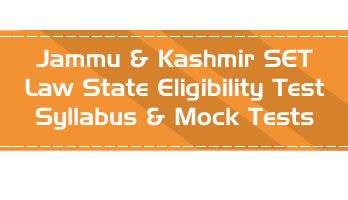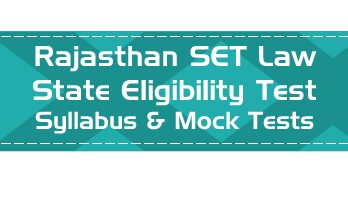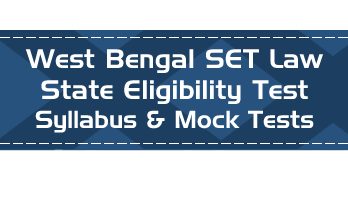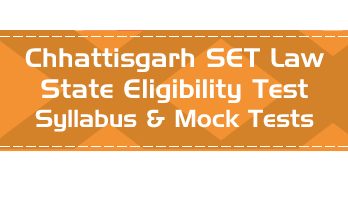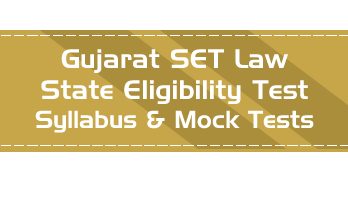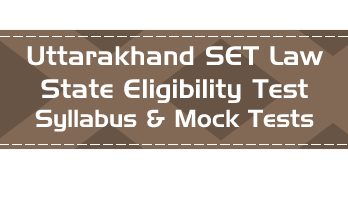- Based on latest Karnataka State Eligibility Test Law Paper II Syllabus
- Law Subjects Overview Material covering important topics and concepts - 650 page PDF Book
- 50 Full Length Mock Tests - New Pattern Paper II, with 100 questions each
- 50 Mini Practice Mock tests - with 25 questions each
- Unlimited Practice - New Questions in every mock test with every attempt
- Answer choices of all questions shuffled randomly for better practice
- Database of over 9500 MCQs covering the entire syllabus
- Includes new comprehension based questions
- Questions & Answer Choices randomly shuffled in every attempt for better practice
- Accessible 24 x 7 via Smart-Phone browsers and Desktops
"Just wanted to let you know that I have cleared JRF with 99.99th percentile. Thank you for all your help and support that made it possible. " - Kanchan Yadav
"Thank you so much for the UGC NET test series. I finally qualified the exam. It was possible because of the mock test series provided by your team." - Robin Jaiswal
1. Who described Jurisprudence as Lawyer’s extraversions ?
(A) Julius Stone
(B) Muller
(C) Lon Fuller
(D) Radcliff
2. Law as a ‘psychological command’ said by
(A) Hans Kelsen
(B) Fredrick Pollock
(C) Ulpian
(D) John Austin
3. Which one of the following is not a source of Law ?
(A) Custom
(B) Legal theory
(C) Legislation
(D) Precedent
4. Assertion (A) : ‘The Jurisdiction of the international court of justice is based on the consent of the parties to the disputes’.<br>Reason (R) : ‘Principles of reciprocity underlines the jurisdiction of international court of justice.’
(A) Both (A) and (R) are true and (R) is correct interpretation of (A)
(B) Both (A) and (R) are true but (R) is not correct explanation of (A)
(C) (A) is true, but (R) is false
(D) (A) is false, but (R) is true
5. Charter of UNO requires that the organisation and its members shall act in accordance with the principles enumerated in the charter. Which of the following is not one of such principles ?
(A) Sovereign equality
(B) Settlement of international dispute by peaceful means
(C) Promotion of Human rights
(D) Prohibition of threat or use of force
6. Delegated Legislation means
(A) Laws made by state legislature
(B) Laws declared by the judges in judicial decisions
(C) Administrative adjudication
(D) Rules, byelaws and regulations made by virtue of statutory powers
7. Hypothesis of ground norm was propounded by
(A) John Austin
(B) Diguit
(C) HLA Hart
(D) Hans Kelsen
8. Match List – I with List – II using the code given below :<br><br>List-I (Theory)<br>a. Retributive theory<br>b. Sociological theory<br>c. Theory of precedent<br>d. Theory of property<br><br>List – II (Subject)<br>i. Legal right<br>ii. Source of law<br>iii. Punishment<br>iv. Roscoe Pound<br><br>Codes : a b c d
(A) i iv iii ii
(B) iii iv ii i
(C) iii ii i iv
(D) iv iii i ii
9. Who among the following has made distinction between ‘distributive Justice’ and ‘Corrective Justice’ ?
(A) Plato
(B) John Austin
(C) John Stuart Mill
(D) Aristotle
10. According to Austin Law is the command of sovereign backed by
(A) Custom
(B) Sanction
(C) Force
(D) Power
11. The concept of ‘Basic structure’ doctrine was first conceived in the case of Sajjan Singh by
(A) Justice Sikri
(B) Justice H. R. Khanna
(C) Justice Krishna Iyer
(D) Justice Janardhan Raghunath Mudholkar
12. Article _____ of the constitution of India provides special provision with respect to goods and service tax.
(A) 246-A
(B) 247-A
(C) 248-A
(D) 249-A
13. 10th Schedule of the Constitution refers to
(A) Land reforms
(B) Local self government
(C) Language
(D) Anti-defection
14. Assertion (A) : The word ‘Minority’ is not defined in the constitution of India.<br>Reason (R) : The minorities commission is not a constitutional body.
(A) Both (A) and (R) are true and (R) is the correct explanation of (A)
(B) Both (A) and (R) are true, but (R) is not a correct explanation of (A)
(C) (A) is true, but (R) is false
(D) (A) is false, but (R) is true
15. Who presides over the meeting of Lok Sabha in the absence of the Speaker ?
(A) Vice President
(B) Deputy Speaker
(C) Deputy Chairman
(D) The Minister of Parliamentary Affairs
16. Which one of the following is not consider under the original jurisdiction of the Supreme Court of India ?
(A) Any dispute between the Government of India and one or more state
(B) Any dispute between the Government of India and any state or states on the one side and one or more other state on the other
(C) Any dispute between two or more states
(D) Any dispute between Government of India and Foreign State
17. Doctrine of ‘Prospective Overruling’ was evolved by the Supreme Court in _______ case.
(A) Keshavananda Bharathi’s case
(B) Shankari Prasad’s case
(C) Sajjan Singh’s case
(D) Golaknath’s case
18. Which of the following conditions are not essential to invoke writ of Quo-warrant ?
(A) It must be a public office
(B) It must be substantive office
(C) Usurpation of public office
(D) He must not be holding the public office
19. The Maxim audi alteram partem is not covered the following
(A) Speaking order
(B) Notice
(C) Pecuniary bias
(D) Legal representation
20. Administrative law is considered as
(A) Wonderful development of the 21st century
(B) Outstanding development of the 21st century
(C) Remarkable development of the 21st century
(D) Revolutionary development of the 21st century
21. Which of the following is not an element of international custom under Article 38 of ICJ ?
(A) Duration
(B) Uniformity and consistency of the practice
(C) Generality of the practice
(D) Opinio Juris et necessitatis
22. International law is a law because states regard it as a law stated by
(A) Hobbes
(B) Austin
(C) Laski
(D) Hart
23. Universal declaration of Human Rights, 1948 was adopted by
(A) U.N. Security Council
(B) U.N. General Assembly
(C) U.N. General Assembly on recommendation of Security Council
(D) League of Nations
24. What basis of persecution does a refugee has ?
(A) Race
(B) Religion
(C) Political reason
(D) All of the options are correct
25. Who accords refugee status to persecuted in India ?
(A) District Court
(B) State Government
(C) Central Government
(D) United Nations
26. Is India a signatory member to the Refugee Status Convention, 1951 and its Protocol 1967 ?
(A) Yes
(B) Yes since 1951
(C) Not a signatory member but in operation since 1981
(D) 14 December 1950
27. Where is the Headquarter of the WTO ?
(A) New York
(B) Washington DC
(C) Geneva
(D) Austria
28. Which of the following institution is associated with Dunkel proposals ?
(A) World Bank
(B) International Monetary Fund
(C) World Trade Organisation
(D) United Nations Organisation
29. Which of the following statement is not true about the WTO ?
(A) WTO is a permanent organisation
(B) Uruguay round gave the birth to the WTO
(C) Ministerial conference is the highest policy making body of the WTO
(D) WTO was officially constituted on 1st Jan. 1991
30. Which of the following statement is not correct ?
(A) Both the IMF and IBRD have headquarter in Washington
(B) Both IMF and world Bank are known as the Brettonwoods Twins
(C) IBRD is known as World Bank also
(D) India’s vote share in the International monetary Fund is 10 percent
31. “Crimes are wrongs whose sanction is punitive and in no way remissible by any private person.” This definition is given by
(A) Lord Macaulay
(B) William Blackstone
(C) Kenny
(D) Sir Henry Maine
32. Which one of the following provision of the Indian Penal Code deals with adulteration of drugs ?
(A) Section 174
(B) Section 373
(C) Section 175
(D) Section 274
33. “Ignorantia facti excusat, ignorantia juris non excusat” means
(A) Ignorance of the fact does not excuse, ignorance of the law excuses
(B) Ignorance of the fact excuses, ignorance of the law does not excuse
(C) Ignorance of the fact and ignorance of law both can be excused
(D) Ignorance of fact and ignorance of law both can not be excused
34. Match List – I with List – II and answer the following using the code given below :<br><br>List – I<br>a. Joseph Shine V. Union of India<br>b. Naz Foundation V. NCT. Delhi<br>c. Preeti Gupta V. State of Jharkhand<br>d. Subhash Babu V. State of A.P.<br><br>List – II<br>1. Section 498 A<br>2. Section 497<br>3. Section 494<br>4. Section 377<br><br>Codes : a b c d
(A) 1 2 3 4
(B) 3 2 4 1
(C) 1 4 3 2
(D) 2 4 1 3
35. Assertion (A) : Detterent theory aims to achieve a preventive measure by dettering an offender from committing crimes in future.<br>Reason (R) : By punishing one person other like minded persons are warned, they may think before taking law into their hands.
(A) Both (A) and (R) are individually true but (R) is the correct explanation of (A)
(B) Both (A) and (R) are individually true but (R) is not correct explanation of (A)
(C) (A) is true, but (R) is false
(D) (A) is false, but (R) is true
36. ‘A by shooting at a fowl with intent to kill and steal it, kill B, who is behind a bush, A not knowing that he was there’. A is
(A) Not guilty of committing culpable homicide
(B) Guilty of committing culpable homicide
(C) Guilty of committing murder
(D) Guilty of committing rash or negligent homicide
37. The criminal law (Amendment) Act, 1983 is popularly known as
(A) Nirbhaya Act
(B) Vishaka Act
(C) Mathura Act
(D) Diya Act
38. The essential ingredients of a crime are
(A) Motive, intention and knowledge
(B) Knowledge, intention and action
(C) Motive, mens rea and actus rea
(D) Mens rea and actus reas
39. To establish Section 34 of Indian Penal Code
(A) Common intention and overt act both be proved
(B) Common intention to be proved but not overt act to be proved
(C) Common intention need not be proved but overt act to be proved
(D) Common intention and overt act both need not be proved
40. A takes a laptop belonging to B out of the possession of B without the consent of B with an intention of keeping it until he gets a reward from B for its restoration. A is guilty of
(A) Cheating
(B) Theft
(C) Extortion
(D) Criminal misappropriation
41. The defence of ‘The plaintiff, the wrong doer’ was explained in
(A) Bird Vs. Hallbrook
(B) Haynes Vs. Harwood
(C) Stanley Vs. Powell
(D) Cates Vs. Sharpe
42. The ‘Pigeon Hole Theory’ is supported by
(A) Austin
(B) Salmond
(C) Winfield
(D) Kenny
43. Vicarious liability is based on which of the following principles ?
(A) Respondeat superior
(B) Res ipsa loquitur
(C) Respondeat poorer
(D) Inherently dangerous and hazardous activity
44. Match List – I with List – II and select the correct answer using the codes given below :<br><br>List – I<br>a. Mersey Dock’s Vs. Proctor<br>b. Metropolitan Asylum District Vs. Hill<br>c. Nichols Vs. Mainland<br>d. Holmes Vs. Mather<br><br>List – II<br>i. Statutory Authority<br>ii. Vicarious liability<br>iii. Inevitable accident<br>iv. Act of God<br><br>Codes : a b c d
(A) i ii iii iv
(B) iii i ii iv
(C) ii i iv iii
(D) iv iii i ii
45. The famous ‘Six Carpenters’ case is related to
(A) Malicious prosecution
(B) False imprisonment
(C) Defamation
(D) Trespasser abinitio
46. The Wagon Mound case is related to which among the following torts ?
(A) Deceit
(B) Misrepresentation
(C) Remoteness of damages
(D) Defamation
47. Which one of the following amounts to nuisance ?
(A) Every unreasonable interference is nuisance
(B) Every reasonable interference is nuisance
(C) Every interference is a nuisance
(D) Non-interference is a nuisance
48. The pecuniary Jurisdiction of a state Commission under New Consumer Protection Act, 2019
(A) Exceeds ten crore, but does not exceed rupees twenty crore
(B) Exceeds one crore, but does not exceed rupees ten crore
(C) Exceeds two crore, but does not exceed rupees hundred crore
(D) Exceeds one crore, but does not exceed rupees twenty crore
49. The Competition Act, 2002 was replaced the
(A) The Monopolies and Restrictive Trade Practices Act, 1969
(B) Foreign Exchange Management Act, 1999
(C) Foreign Exchange Regulation Act, 1973
(D) Companies Act, 1956
50. Read Assertion (A) and Reason (R) and give the correct answer by using the codes given below :<br>Assertion (A) : ‘A’ opens a hotel infront of B’s hotel. All the customs of B patronise ‘A’. ‘B’ cannot claim damages from ‘A’.<br>Reason (R) : There is a Latin maximum damages sine injuria.
(A) Both (A) and (R) are true and (R) is the correct explanation of ‘A’
(B) Both (A) and (R) are true, but (R) is not the correct explanation of (A)
(C) (A) is true, but (R) is false
(D) (A) is false, but (R) is true
… Subscribe to our online mock tests & previous paper series for the full question paper, with answer key.
- Based on latest Karnataka State Eligibility Test Law Paper II Syllabus
- Law Subjects Overview Material covering important topics and concepts - 650 page PDF Book
- 50 Full Length Mock Tests - New Pattern Paper II, with 100 questions each
- 50 Mini Practice Mock tests - with 25 questions each
- Unlimited Practice - New Questions in every mock test with every attempt
- Answer choices of all questions shuffled randomly for better practice
- Database of over 9500 MCQs covering the entire syllabus
- Includes new comprehension based questions
- Questions & Answer Choices randomly shuffled in every attempt for better practice
- Accessible 24 x 7 via Smart-Phone browsers and Desktops
"Just wanted to let you know that I have cleared JRF with 99.99th percentile. Thank you for all your help and support that made it possible. " - Kanchan Yadav
"Thank you so much for the UGC NET test series. I finally qualified the exam. It was possible because of the mock test series provided by your team." - Robin Jaiswal


